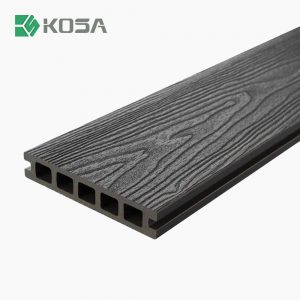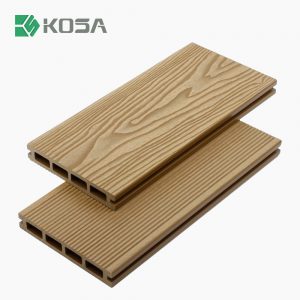WPC Fence (composite fencing) are made of wood powder and plastic materials such as high-density polyethylene (HDPE) or polypropylene (PP), which are extruded at high temperatures and then surface-treated to give them the texture and appearance of wood. This material is not only weather-resistant, but also corrosion-resistant, waterproof, moisture-proof, and insect-proof. Compared with traditional wooden fences, wood-plastic fences do not require anti-corrosion treatment, reducing damage to the environment.

Composite fencing are widely used in garden landscapes. Their advantage is that they combine the natural beauty of wood with the durability of plastic, adding a unique charm to the garden landscape. The following are some specific applications and advantages of WPC Fence in gardens and landscapes:

Aesthetics:
Composite fencing have various appearance designs and can be designed according to different garden styles, such as modern simplicity, Chinese classical style or European romantic style, etc. Its color and texture can be coordinated with surrounding plants, water bodies, buildings and other landscape elements to create a harmonious and unified visual effect.
Environmental protection:
Composite fencing is a new environmentally friendly material that combines the advantages of wood and plastic. The raw materials come from renewable wood powder and recyclable plastic. It has the characteristics of low energy consumption, recyclability, and low carbon emissions.
Safety:
Composite fencing can play an important safety role at the edges of rivers, ponds and other waters. Its solid structure and stable performance can effectively prevent people from accidentally falling into the water and ensure the safety of tourists.
Environmental protection:
Composite fencing are made of renewable materials and are in line with the concept of sustainable development. Compared with traditional wood guardrails, composite fencing do not require a large number of felling trees and help protect forest resources.
Weather resistance:
Due to the addition of plastic components to the wood-plastic guardrail, it is UV-resistant, corrosion-resistant and water-resistant. Even under harsh climate conditions, it can maintain its original beauty and functionality, and will not suffer from problems such as cracking and fading due to climate changes.
Diverse choices:
Composite fencing can be customized according to personal preferences and needs, with different colors, textures and styles available. At the same time, different heights and shapes can also be selected according to the characteristics of the site to meet the needs of different scenes. Whether it is a simple modern style or a simple and natural style, wood plastic fence can provide you with a variety of choices.
Easy to install and maintain:
The installation process of composite fencing is simple and convenient, and does not require special tools and skills. No nails or screws required, just insert the posts into the base to complete the installation. This design not only saves installation time, but also reduces installation costs. Whether it’s a personal home or a commercial project, wood plastic fencing provides a quick and efficient installation solution. At the same time, its maintenance is relatively simple. The surface of the wood-plastic fence has been specially treated to prevent dirt and dust from adhering to it, making it very convenient to clean. Just rinse with clean water or wipe with a damp cloth to keep the fence looking great. Compared with traditional wooden fences, wood-plastic fences do not require regular painting or anti-corrosion treatment, which greatly reduces the workload and cost of maintenance.
In garden landscape design, composite fencing can be used in a variety of scenarios, such as courtyards, parks, scenic spots, etc. Designers can choose the appropriate wood plastic guardrail type and style according to the specific environment and needs to achieve the best landscape effect. In addition, wood plastic guardrails can also be combined with other landscape elements to create more diverse landscape spaces.
In short, the application of composite fence in garden landscapes has many advantages, not only beautiful and practical, but also environmentally friendly and safe. As people’s requirements for the quality of garden landscapes continue to increase, composite fencing will be applied and promoted in more fields.





